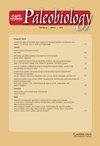Morphological evolution during the last hurrah of the trilobites: morphometric analysis of the Devonian asteropyginid trilobites
IF 2.6
2区 地球科学
Q2 BIODIVERSITY CONSERVATION
引用次数: 0
Abstract
Abstract. The Asteropyginae Delo, 1935 is a group of phacopid trilobites in the family Acastidae Delo, 1935 that has served as the focus for several studies due to their distinctive morphologies and diversity. However, despite an interest in these characteristic morphologies, there have been no studies that have examined this group using morphometric techniques. Our investigation utilized both geometric morphometric and elliptical Fourier methods to quantify the morphology of cephalic sclerites of asteropyginid specimens representing wide taxonomic sampling of the clade. We constructed a phylomorphospace that shows temporal and spatial patterns of phenotypic evolution within the framework of a novel tip-dated phylogenetic tree generated using Bayesian inference. We recovered similar patterns in disparity regardless of the morphometric approach. Both analyses illustrated a marked expansion into morphospace throughout the temporal range of the clade, peaking in disparity in the Emsian and with European taxa exhibiting the highest disparity in glabellar morphospace. Additionally, glabellar shape showed low phylogenetic signal and no major patterns in phylomorphospace. This study highlights the utility of employing different methodologies to quantitatively explore the disparity of fossil taxa. It also illustrates some of the patterns of morphological change occurring during one of the final and major evolutionary radiations within Phacopida.三叶虫最后欢呼期的形态演化——泥盆纪星形三叶虫的形态计量学分析
摘要Asteropyginae Delo,1935是Acastidae Delo(1935)科中的一组有相三叶虫,由于其独特的形态和多样性,已成为几项研究的焦点。然而,尽管人们对这些特征形态感兴趣,但还没有使用形态计量技术对这一群体进行检查的研究。我们的研究利用几何形态计量学和椭圆傅立叶方法来量化代表该分支广泛分类抽样的紫苑标本的头部巩膜炎的形态。我们构建了一个系统形态空间,在使用贝叶斯推理生成的新的尖端系统发育树的框架内显示表型进化的时间和空间模式。无论形态计量方法如何,我们都恢复了相似的视差模式。这两项分析都表明,在整个分支的时间范围内,形态空间显著扩展,在埃姆西亚的差异达到峰值,欧洲分类群在眉间形态空间中表现出最高的差异。此外,眉间形态显示出较低的系统发育信号,在门形态空间中没有主要模式。这项研究强调了使用不同方法来定量探索化石分类群差异的实用性。它还说明了在Phacopida的最后一次也是主要的进化辐射中发生的一些形态变化模式。
本文章由计算机程序翻译,如有差异,请以英文原文为准。
求助全文
约1分钟内获得全文
求助全文
来源期刊

Paleobiology
地学-古生物学
CiteScore
5.30
自引率
3.70%
发文量
38
审稿时长
>12 weeks
期刊介绍:
Paleobiology publishes original contributions of any length (but normally 10-50 manuscript pages) dealing with any aspect of biological paleontology. Emphasis is placed on biological or paleobiological processes and patterns, including macroevolution, extinction, diversification, speciation, functional morphology, bio-geography, phylogeny, paleoecology, molecular paleontology, taphonomy, natural selection and patterns of variation, abundance, and distribution in space and time, among others. Taxonomic papers are welcome if they have significant and broad applications. Papers concerning research on recent organisms and systems are appropriate if they are of particular interest to paleontologists. Papers should typically interest readers from more than one specialty. Proposals for symposium volumes should be discussed in advance with the editors.
 求助内容:
求助内容: 应助结果提醒方式:
应助结果提醒方式:


